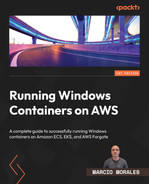Scale up your Windows containers seamlessly on AWS powered by field-proven expertise and best practices on Amazon ECS, EKS, and Fargate Purchase of the print or Kindle book includes a free PDF eBook Windows applications are everywhere, from basic intranet applications to high-traffic public APIs. Their prevalence underscores the importance of combining the same tools and experience for managing a modern containerized application with existing critical Windows applications to reduce costs, achieve outstanding operational excellence, and modernize quickly. This comprehensive guide to running and managing Windows containers on AWS looks at the best practices from years of customer interactions to help you stay ahead of the curve. Starting with Windows containers basics, you'll learn about the architecture design that powers Amazon ECS, EKS, and AWS Fargate for Windows containers. With the help of examples and best practices, you'll explore in depth how to successfully run and manage Amazon ECS, EKS, and AWS Fargate clusters with Windows containers support. Next, the book covers day 2 operations in detail, from logging and monitoring to using ancillary AWS tools that fully containerize existing legacy .NET Framework applications into containers without any code changes. The book also covers the most common Windows container operations, such as image lifecycle and working with ephemeral hosts. By the end of this book, you'll have mastered how to run Windows containers on AWS and be ready to start your modernization journey confidently. This book is targeted towards DevOps engineer, SREs, solution architects, or a Windows sysadmin who wants to learn more about running Windows containers on AWS. In order to learn from this book, you should have a basic understanding of containers, Docker, and Kubernetes. The book is also beneficial for Windows application developers who want to explore how to achieve better application scalability using containers as a compute layer.Key Features
Book Description
What you will learn
Who this book is for
Table of Contents
- Running Windows Containers on AWS
- Contributors
- About the author
- About the reviewer
- Preface
- Part 1: Why Windows Containers on Amazon Web Services (AWS)?
- Chapter 1: Windows Container 101
- Chapter 2: Amazon Web Services – Breadth and Depth
- Part 2: Windows Containers on Amazon Elastic Container Service (ECS)
- Chapter 3: Amazon ECS – Overview
- Chapter 4: Deploying a Windows Container Instance
- Chapter 5: Deploying an EC2 Windows-Based Task
- Chapter 6: Deploying a Fargate Windows-Based Task
- Part 3: Windows Containers on Amazon Elastic Kubernetes Service (EKS)
- Chapter 7: Amazon EKS – Overview
- Chapter 8: Preparing the Cluster for OS Interoperability
- Chapter 9: Deploying a Windows Node Group
- Chapter 10: Managing a Windows Pod
- Part 4: Operationalizing Windows Containers on AWS
- Chapter 11: Monitoring and Logging
- Chapter 12: Managing a Windows Container's Image Life Cycle
- Chapter 13: Working with Ephemeral Hosts
- Chapter 14: Implementing a Container Image Cache Strategy
- Chapter 15: AWS Windows Containers Deployment Tools
- Index
- Other Books You May Enjoy
